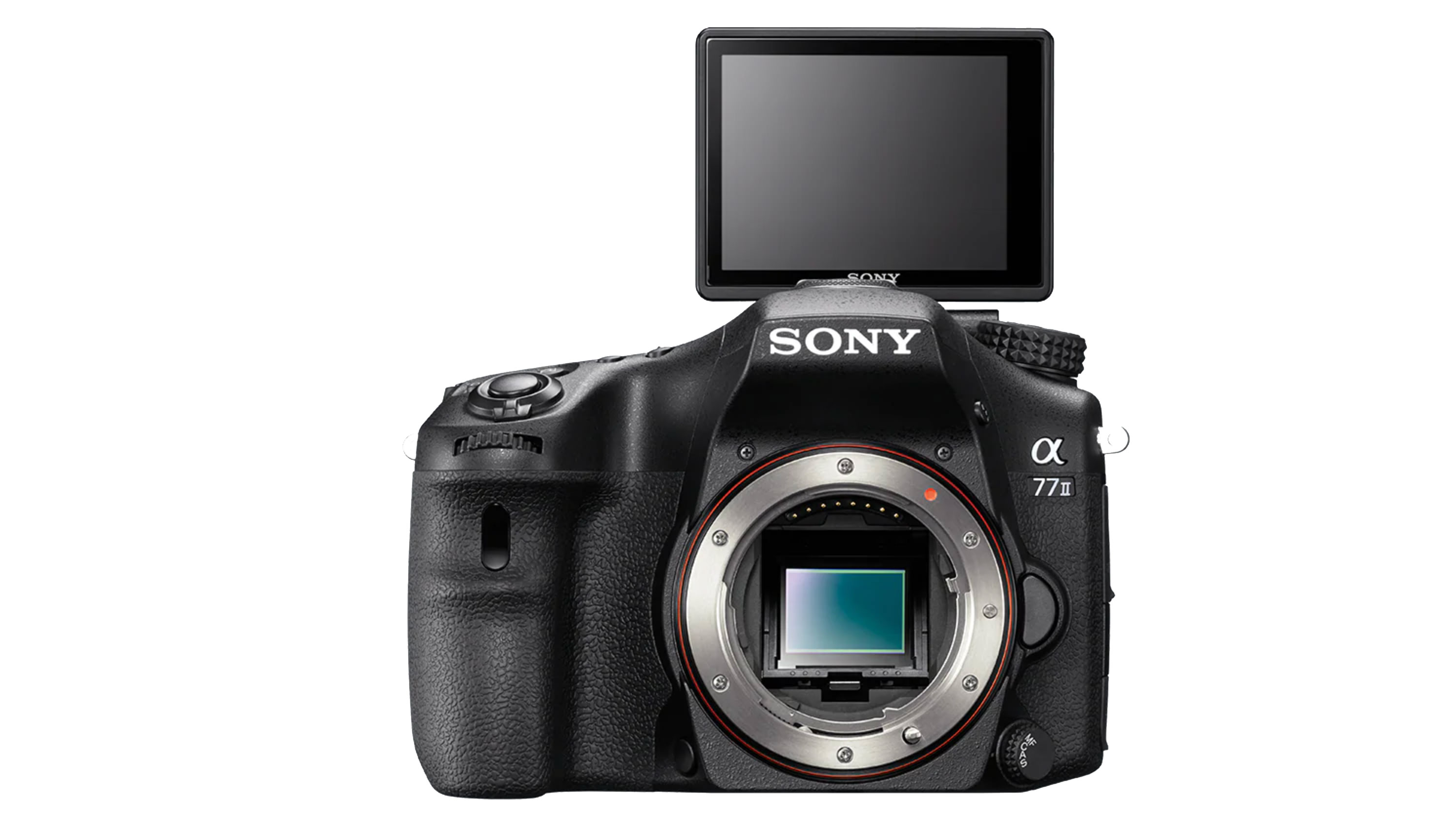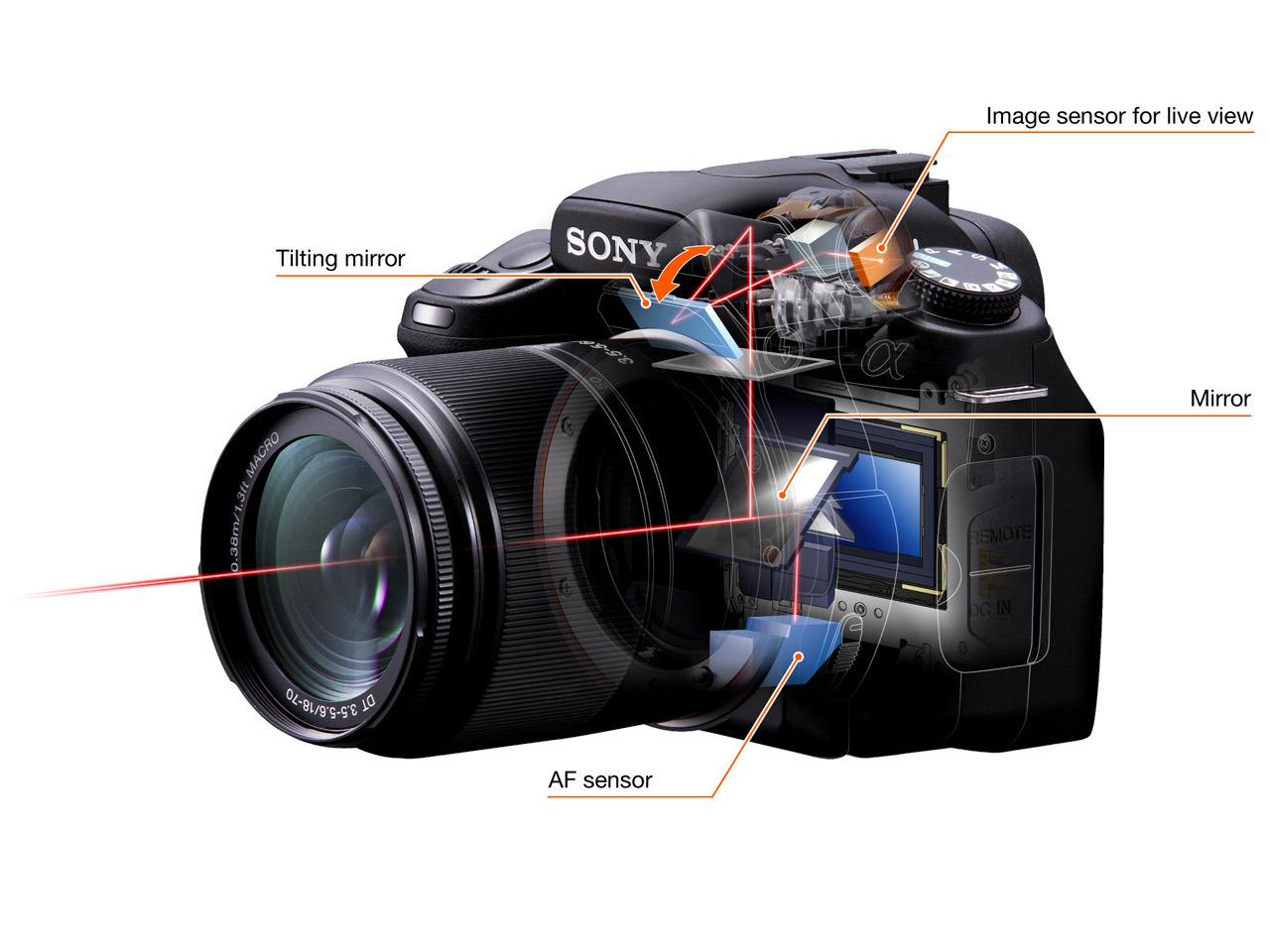So the Sony Alpha SLT is dead? Well, boo hoo. An obituary
Sony has not always had the Midas touch. This was a mirrorless camera with a mirror, a DSLR with an EVF. What?!

When it launched its range of SLT (Single Lens Translucent) cameras, Sony’s logic made a certain amount of sense – if you kept your hands over your ears and one eye closed.
What people wanted, Sony argued, was the speed of a phase-detect autofocus system and a digital live view combined. Back then, the only way to get fast phase-detect AF was with a separate sensor in the optical light path. This is how DSLRs work to this day.
Remember, this was when on-sensor phase detect systems did not exist and sensors could only offer slow and plodding contrast AF. The bigger the sensor, the slower and more plodding it became.
Less Alpha, more Beta
Sony’s solution was to use a fixed, translucent mirror to reflect a part of the image to a regular and separate DSLR type phase detect sensor up where the focusing screen would have been in a DSLR, and the rest of it through to the sensor at the back of the camera.
So yes, you read that right. That big fat mirror the size of your living room window was ONLY to feed the phase detect AF sensor – not an optical viewfinder.
That was disappointing. When Sony Alpha SLTs were first released (the Sony A33, 2010), EVFs weren’t great. It was like looking at a computer screen versus looking out of your window. We exaggerate, but EVFs back then were not even a shadow of what they are now.
True, the fixed mirror didn’t slam up and down each time you took a picture. But why didn’t it bounce the image back up into a regular pentaprism viewfinder? Because the AF module would be in the way and – perhaps – because Sony was keen to switch to a fully digital display system, where the viewfinder and the rear screen displayed exactly the same thing (unlike a DSLR).
The best camera deals, reviews, product advice, and unmissable photography news, direct to your inbox!
From DSLR to SLT
Sony’s Alpha line was born out of its acquisition of Minolta cameras in 2006, which gave Sony the foothold it needed in the interchangeable lens camera market.
Sony did actually make regular DSLRs at the start. Anyone remember the original Sony A100, the A200, A230, A290, A300, A330, A350, A380, A390, A450 A500, A550, A560, A580, A700, A850, or the A900?
So then came the swap from DSLR to SLT. The optical viewfinder went but the mirror stayed. Pity it couldn’t have been the other way round.
These were all early Sony DSLRs which reviewed pretty well at the time but clearly didn’t dent Canon and Nikon’s dominance in the DSLR market to the degree that Sony hoped.
It’s not like they weren’t trying.
So then came the swap from DSLR to SLT. The optical viewfinder went but the mirror stayed. Pity it couldn’t have been the other way round.
From 2010 we had a long succession of SLT models, including the Sony A33, A35, A37, A55, A57, A58, A65, A68, A77 (and A77 II) and A99 (and A99 II), all taking a growing list of quite decent and modern Alpha mount lenses (that’s ‘Alpha’ the mount, not ‘Alpha’ the brand), all with the same size and heft of a DSLR, but with the SLT design.
Mounting pressure
Sony’s Alpha DSLRs and SLTs used the same lens mount, but lenses came in two different sizes for APS-C cameras and full frame models. So far so good. Lots of camera makers have two different lens sub-ranges for different sensor sizes.
In 2010, however, Sony also launched its new mirrorless camera range, initially with the NEX prefix but also known as ‘Alpha’. The first models used APS-C sensors but in 2013 Sony introduced its first full frame mirrorless cameras. So now there was a new mirrorless ‘E-mount’, also with APS-C and full frame lenses, so that there were four possible Sony lens mount and size combinations and two different camera designs, both ‘Alphas’.
But not actually ‘Alphas’ of course. To this day, Sony likes them described with a lower case Greek ‘α’ character, which only one person in a thousand (estimate) can find on their keyboard.
Now that the Sony Alpha line is no more (that’s the Alpha DSLRs and SLTs, not the Alpha mirrorless cameras), the lens situation is less confused. And you can still use old Alpha lenses on new E-mount cameras with full functionality via the Sony LA-EA5 35mm Full-Frame A-Mount Adapter.
The end of a (short) era
Sony’s SLT cameras were not so much bad as bizarre, a short-lived experiment that must have made sense to Sony at the time, if not the rest of us.
So to be clear, this was a mirrorless camera with a mirror, and a DSLR with an EVF. In order to get fast phase detect AF and live view at the same time, Sony sacrificed what many would consider to be the chief advantages of both camera types.
Even then, EVEN THEN, the Sony Alpha SLT looked like a mongrel, a camera that was worse than a DSLR and also worse than the genuinely mirrorless cameras that would soon follow.
Over the years, Sony has got a lot of things right but a few things wrong. Guess where we’re going to categorise the Sony Alpha SLT.
Read more:
• Best Sony cameras
• Best Sony lenses
• Best mirrorless cameras
• Best DSLRs
• Best professional cameras
• Best beginner cameras

Rod is an independent photography journalist and editor, and a long-standing Digital Camera World contributor, having previously worked as DCW's Group Reviews editor. Before that he has been technique editor on N-Photo, Head of Testing for the photography division and Camera Channel editor on TechRadar, as well as contributing to many other publications. He has been writing about photography technique, photo editing and digital cameras since they first appeared, and before that began his career writing about film photography. He has used and reviewed practically every interchangeable lens camera launched in the past 20 years, from entry-level DSLRs to medium format cameras, together with lenses, tripods, gimbals, light meters, camera bags and more. Rod has his own camera gear blog at fotovolo.com but also writes about photo-editing applications and techniques at lifeafterphotoshop.com





